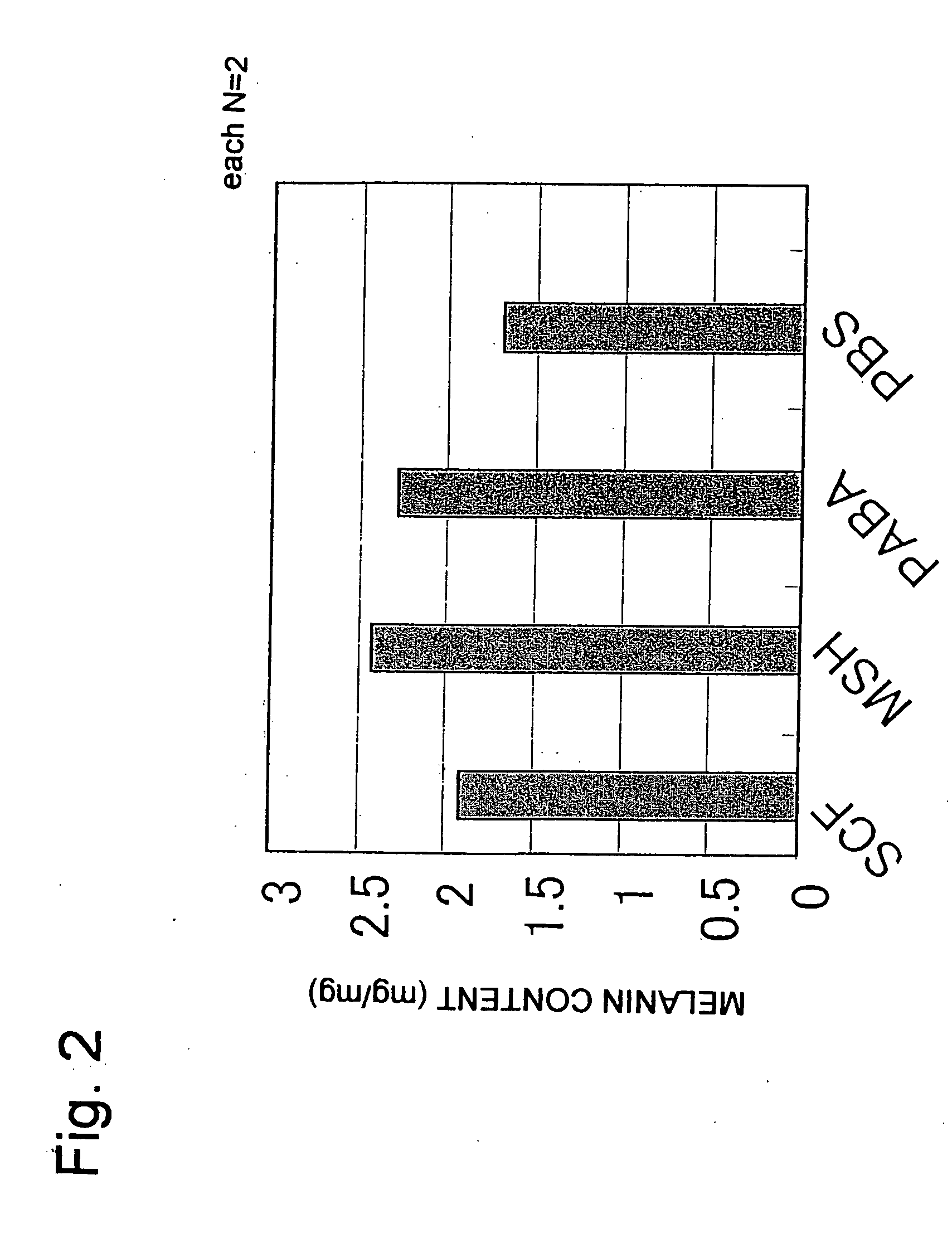Hair follicle-reconstitution system and animal carrying the same
a hair follicle and system technology, applied in the field of hair follicle-reconstitution system and animal carrying the same, can solve the problems of hair grazing, decreased or disappeared melanocytes, etc., and achieve the effect of deepening the color of whole hair
- Summary
- Abstract
- Description
- Claims
- Application Information
AI Technical Summary
Benefits of technology
Problems solved by technology
Method used
Image
Examples
example 1
Mouse-Derived Hair Papilla Cells
[0038] (1-1) There is selected a LacZ positive one from neonates (to be used within four days of birth) which are born from transgenic mouse into which there has been introduced an expression vector which is prepared by connecting structural gene of a suitable marker protein (e.g., LacZ) to the downstream of Vercican promoter.
[0039] (1-2) Each mouse is washed with ethanol and suitable washing liquid (e.g., phosphate-buffered saline; to be abbreviated to PBS). Then, skin on the back portion is peeled off, and is left still overnight in 0.25% trypsin / PBS at 4.degree. C.
[0040] (1-3) Next day, epidermis and dermis are separated from each other by use of pincette or the like. Then, the side which contains dermis is treated with 0.35% collagenase / DMEM (Dulbecco-Modified Eagle's Minimum Essential Medium) for about one hour at 37.degree. C.
[0041] (1-4) The sample of (1-3) is subjected to a careful suspension operation, and is then passed through a cell strain...
example 2
Mouse-Derived Epidermal Cells
[0044] (2-1) On the day before operation, skin from neonate of albinic mouse (e.g., ICR strain) is treated with trypsin by the same manner as in (1-1) and (1-2).
[0045] (2-2) Only epidermal portion is peeled off with use of pincette or the like. Said epidermal portion is cut fine, and is then subjected to a suspension treatment in a suitable culture liquid (e.g., keratinocyte culture medium, to be abbreviated to KGM) at 4.degree. C. for about one hour.
[0046] (2-3) The sample of (2-2) is passed through a cell strainer having a pore size of 70 .mu.m, and is subsequently centrifuged, and, thus, epidermal cells are recovered.
[0047] (2-4) Per one recipient animal, there are used, for operation, epidermal cells in an amount corresponding to two neonates. Cells in said amount are suspended with use of KGM, and are then left to stand still on ice until immediately before use. Or, otherwise, the recovered cells may be freeze-preserved, to be defrosted before use.
example 3
Mouse-Derived Dermal Cells
[0048] (3-1) On the day before operation, skin from neonate of albinic mouse (e.g., ICR strain) is treated with trypsin by the same manner as in (1-1) and (1-2).
[0049] (3-2) Epidermal portion is peeled off with use of pincette or the like. Remaining dermis is cut fine, and is then subjected to a suspension treatment in a suitable culture liquid (e.g., DMEM+10% FBS) which contains 0.35% collagenase at 37.degree. C. for about one hour.
[0050] (3-3) The sample of (3-2) is passed through a cell strainer having a pore size of 100 .mu.m, and is subsequently centrifuged, and, thus, dermal cells are recovered.
[0051] Per one recipient animal, there are used, for operation, dermal cells in an amount corresponding to two neonates. These dermal cells are not used simultaneously with isolated hair papilla cells. Cells in said amount are suspended with use of a liquid such as DMEM+10% FBS, and are then left to stand still on ice until immediately before use or freeze-pres...
PUM
| Property | Measurement | Unit |
|---|---|---|
| diameter | aaaaa | aaaaa |
| pore size | aaaaa | aaaaa |
| pore size | aaaaa | aaaaa |
Abstract
Description
Claims
Application Information
 Login to View More
Login to View More - R&D
- Intellectual Property
- Life Sciences
- Materials
- Tech Scout
- Unparalleled Data Quality
- Higher Quality Content
- 60% Fewer Hallucinations
Browse by: Latest US Patents, China's latest patents, Technical Efficacy Thesaurus, Application Domain, Technology Topic, Popular Technical Reports.
© 2025 PatSnap. All rights reserved.Legal|Privacy policy|Modern Slavery Act Transparency Statement|Sitemap|About US| Contact US: help@patsnap.com


